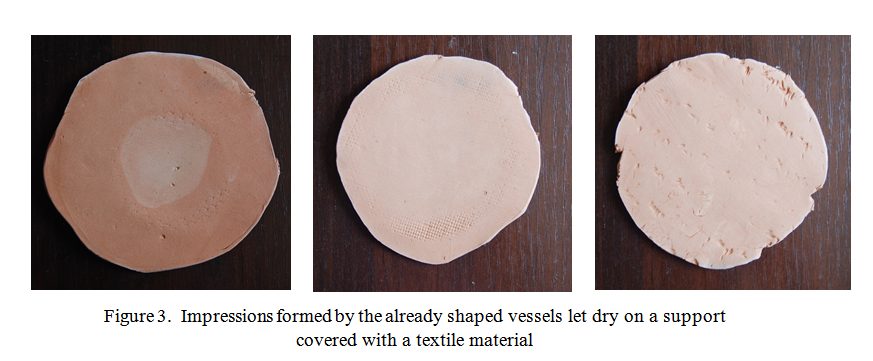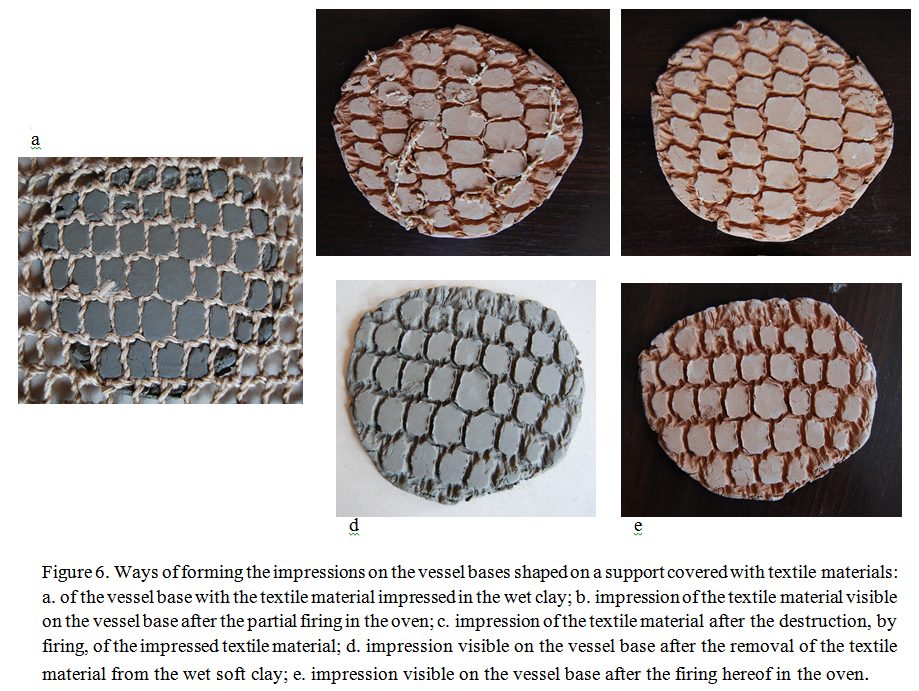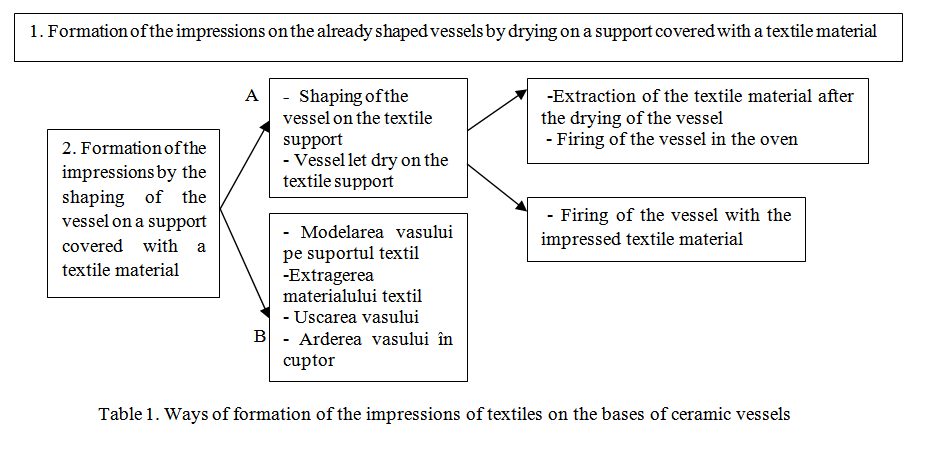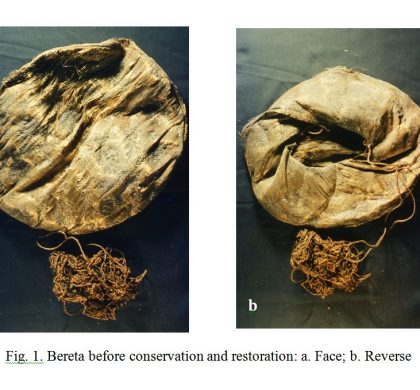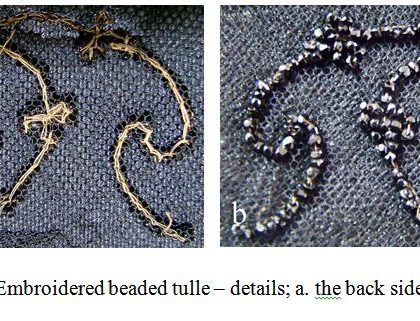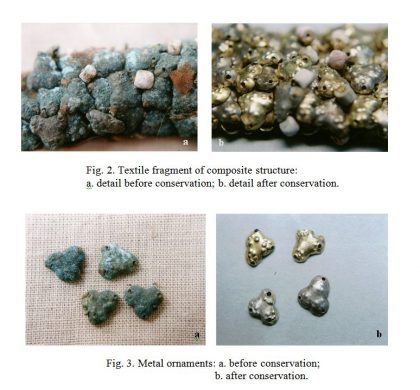Hypotheses Regarding the Formation of Textile Impressions on the Cucuteni Ceramicware. Experimental Researches
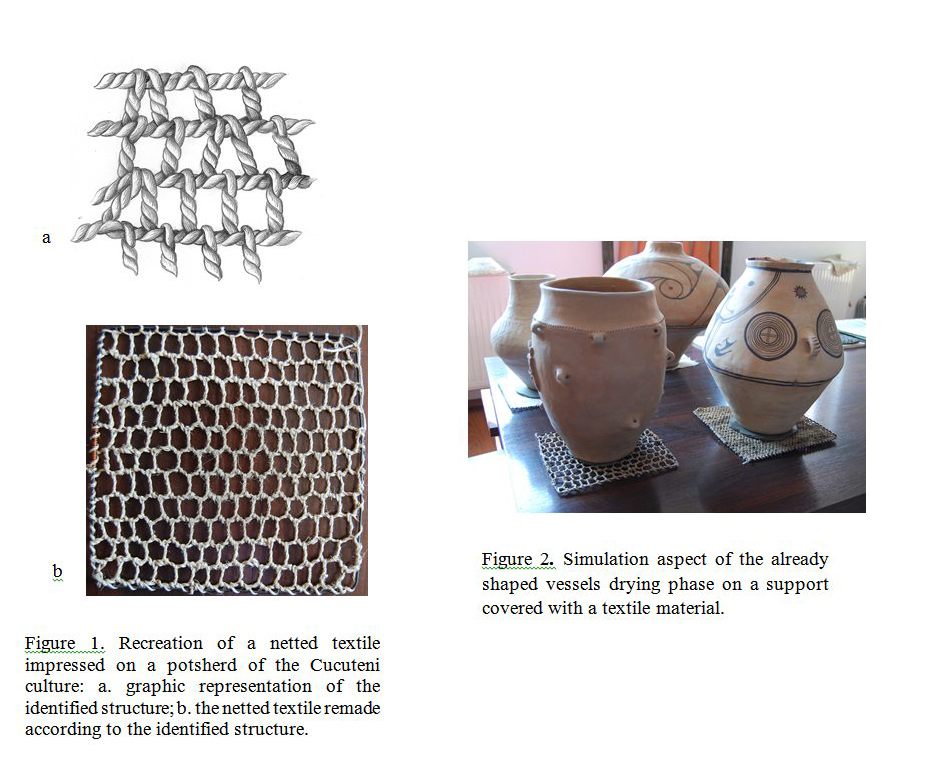
Abstract. With the occasion of the archeological researches undertaken throughout time in the settlements of the Cucuteni civilization, there were discovered potsherds from the sustaining base of vessels, which contained impressions of textile materials. The abstract shows the experimental researches undertaken in order to recreate the manner of formation of such impressions, pointing out aspects pertaining to the usage of textile materials in the making of the vessels. Researches undertaken in collaboration with plastic artist ceramist/pottery artisan, by using the same type of instruments and working methods, aimed at obtaining a result similar to the one obtained in prehistoric times. In this regard, the recreation of the process of making the ceramic vessels involved the usage of textile materials specific to the Cucuteni culture, which could be reconstructed using previously available information, with different structures and widths, for covering the stand on which vessels were shaped / let dry. The researches correlated the characteristics of the used textile materials with the depths of the formed impressions and the dimensions of the vessels. Experiments pointed out aspects which led to new hypotheses as for the formation of the impressions of textile materials. Thus, in the case of shaping the large vessels we could point out the usage of textile materials as support used for transporting the vessels after shaping, while still wet, for being stored in the place where they would be let dry, and then, when dry, for being inserted in the oven where they were fired together with the textile material.
Keywords: Cucuteni, textile, ceramic ware, impressions, ethnoarcheology
- General considerations regarding the impressions of textile materials on the Cucuteni ceramic ware.
The researches described in this paper are part of the preoccupations meant to enlarge the understanding of aspects pertaining to the making of the vessels of the Cucuteni culture, more precisely of the usage of textiles in the process of shaping/ drying of the clay these vessels were made of.
With the occasion of the archeological researches undertaken in the settlements of the Cucuteni civilization there were discovered archeological potsherds, representing the sustaining base of vessels which belonged to phases A and B. On the outer surface of these potsherds there were impressed the contexture of textile materials made using the technique of weaving / netting textile threads, materials such as bulrush, straw, grass threads or wickers. Researching these potsherds we obtained information regarding both the temporal and spatial evolution of textile technologies, and new aspects regarding the technology of preparing the ceramic vessels.
The presence of the impressions of textile materials on the archeological vessels is due to the usage of these materials either in the process of shaping /drying the vessels or for the ornamentation thereof. In the process of making the vessels, textile materials were used as an intermediary layer, for covering the tough support on which vessels were shaped / let dry. In these conditions, the superficial structural elements of the textile materials, being in direct contact with the humid and soft clay, were impressed on the bottom of the vessel. The research of these impressions allowed the reconstruction of the structure of the impressed textile materials – items which were either woven or netted in various techniques [4]. Due to the granulometric features of the material on which the textile materials were impressed, respectively clay, the impressions could not render closely the microscopic details of the fiber structure. For these reasons, researches undertaken so far have not been able to identify the nature of the used raw material – vegetal or animal, but only technological features which included the structural parameters of threads and textiles.
The study of the archeological items from a single perspective does not provide complete data regarding the recreation of the processes specific to prehistoric times. In this regard, the manufacture technology of prehistoric vessels could be only partly documented through the scientific investigation of the archeological finds, the determination of the work methodology requiring the identification of analogies with elements of ethnography and the relation to the technical possibilities of the period the studied artifacts are dated to. For this reason, the ethnographic method has been lately more and more applied in the interpretation of ancient vestiges, by analogy with the information provided by human communities that practice crafts in traditional forms. The study of the occupations, way of life, seasonal and traditional professions and crafts within the space inhabited by the concerned community allows for a complex exploration for the recreation as true as possible of the way of life characteristic for communities of the remote past.
Cucutenian ceramic ware was hand-made, without any potter’s wheel, which is acknowledged on this territory much later. Still, it seems that in the Cucuteni culture potters were already aware of the rotating movement as indicated by the strong alignment of small grains present in the composition of clay, both in the center of the vessel walls and along the sides, a rather unusual situation for that time. Other indirect proofs seem to demonstrate the usage of rotating systems facilitating the making of the vessels, such as: the internal constant folds, parallel and horizontal which can be noticed on the inner sides of the walls of certain vessels of the Cucuteni culture. These rudimentary vessel rotating systems used in the process of shaping (vessel bottoms used as support or mats and textile materials having t the same role), actuated either by the one who shaped the vessel or by another person, are considered as forerunners of the potter’s wheel. The interpretation from this perspective of the impressions of textile materials on the vessel bottoms is advanced by various specialists (Anghel, 2006, 393-403; Marian 2008; Moldovan 2006, 403-421). It is thus considered that the depth of the impressions suggest the shaping of the clay on a shaping support, separated from the clump of clay by a mat or a textile material (Voinea 2006, 9-34). The simple drying of the vessels on a support covered with a textile material cannot leave behind such firm impressions, especially in the case of small vessels. It was only due to the high pressure applied while shaping that the impressions could become so deep. Certain ethnographic analogies come to endorse this interpretation. For instance, throughout the areal of the locality Cucuteni, even nowadays the shaping mass used for the hand making of vessels is covered with a textile material to prevent the sticking of the clay to its support and to facilitate the spinning of the vessel. Similarly, women of Oaxaca, Mexico, make even nowadays ceramic vessels using a piece of leather or a textile material for facilitating their rotation while shaping (Moldovan 2006, 403-421). This shaping technique seems to have known a wide spreading in the southeast of Europe, numerous impressions of textile materials being also present in other neo-Eneolithic cultures of this space.
Small vessels were created by the shaping of a clay clump, deepened and narrowed until a certain shape was achieved. In the case of larger vessel, the round bottom would be first executed on its rims, strips of clay of variable diameters being attached one on top of the other (Sandu et al, 2010, 112-114). The evening of the walls both inside and outside the vessel could not be achieved with the fingers which would have left their prints, but with aiding tools made of wood, bone, fired clay etc.
- Hypotheses regarding the way of formation of the impressions of textile materials on the bottom of ceramic vessels. Experimental researches.
The present research aims at experimentally recreating the succession of the phases involved in the creation of the Cucutenian vessels. To do this, the researcher used the input of potter / ceramic artist so that, through the usage of the same instruments and work methods, we could try to obtain a result as similar as possible to the prehistoric one.
Taking into account that, regarding the way of formation of the impressions on the archaeological vessels, there are several opinions, experimental ongoing researches took into account two possible variants.
– the formation of the impressions through the drying on a support covered with a textile material of the already shaped vessels;
– the formation of the impressions through the shaping of vessels on a support covered with a textile material.
The first phase of the experimental researches consisted in the recreation of textile materials similar to those used by the human communities of the Cucuteni culture. The recreation was done based on the information obtained following the researches of the impression of textile materials as preserved on the bottom of Cucutenian vessels discovered within the archaeological excavations (Marian 2008). Thus, there were recreated three types of textile materials with different widths and structures: a fine cloth, made in cloth weave, a coarse netting made by means of a procedure similar to the Alençon lace (Figure 1) and a netting obtained by means of the nalbinding procedure.
2.1. Formation of the impressions on the already shaped vessels let dry on a support covered with a textile material.
During the first phase of the experimental researches, there were shaped separately vessels bases which were let dry on reconstructed textiles. To simulate the drying phase on a textile support of shaped vessels, on top of the shaped bases there were placed previously made vessels, of various forms and weights, which were kept in position until the complete drying of the above bases (Figure 2). The impressions created in these experimental circumstances are superficial and not well defined (Figure 3).
2.2. Formation of the impressions by the shaping of the vessel on a support covered with a textile material.
In this case experiments remade the succession of the working phases in the elaboration of the Cucutenian vessels, through the shaping of the clay on a support covered with reconstructed textile materials (Figure 4). Impressions formed in these circumstances are much clearer and deeper if compared to those obtained in the previous experimental conditions (Figure 5).
In the case of shaping of larger vessels, textile materials of coarser threads are used to cover the shaping support (this is the case of the potsherd of a food storage pot discovered at Trușești) (Marian 2008). Under this circumstance, during the experimental researches two work variants were considered, marked A and B: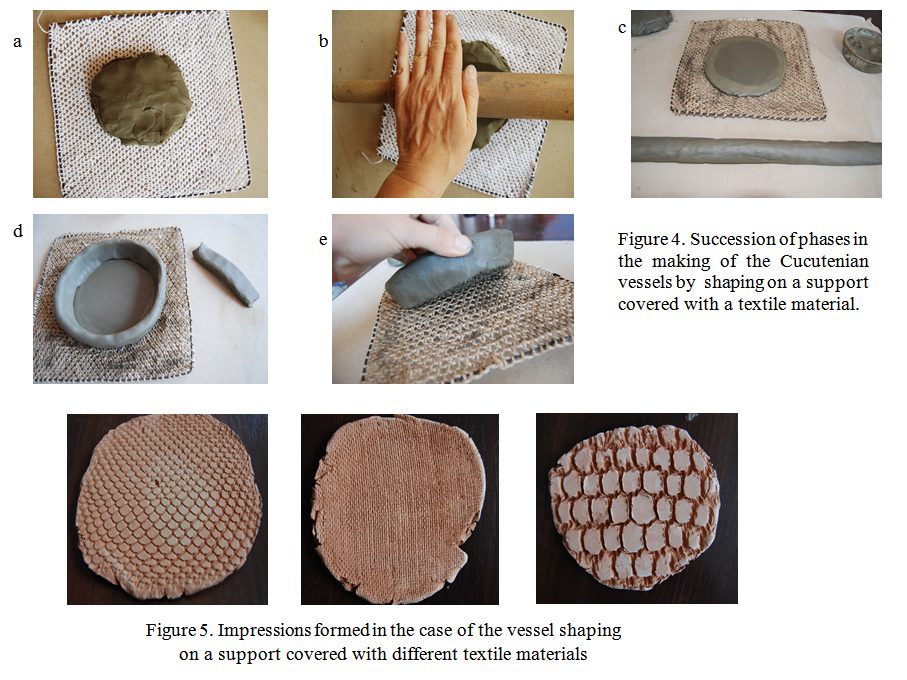
A. The shaping of the vessel on a support covered with textile material and the drying of the vessel in this position. In the case of a large vessel, the textile material made of coarser threads shall be deeply impressed in the mass of the clay and its extraction after the vessel drying shall determine the deterioration of the vessel base. For this reason, this first work hypothesis has been considered as unrealistic.
Within this work variant we can though formulate a second hypothesis according to which after the shaping and drying of the textile material, the vessel was inserted into the firing oven together with the textile material. During the firing process, the organic textile material was destroyed the ceramic preserving impressed after firing only the impression thereof (Figure 6a, 6b, 6c). Thus, within the experimental researches, the impressions of the textile materials formed of coarser threads are similar to those preserved on the archeological vessels. These observations suggest that this hypothesis can be real. This work variant also points out the possibility of usage of the coarse textile materials also as a support for transporting large vessels after shaping, while still wet, for being deposited at the place meant for drying and then when dry for being introduced in the firing oven.
B. The shaping of the vessel on a support covered with a textile material, the removal of the textile
material impressed in the wet soft clay, the drying of the vessel and the firing in the oven. In this case, the extraction of the textile material made of coarser threads deeply impressed in the soft clay results into the displacement of the clay and the heightening of the outline of the formed impression (Figure 6a, 6d, 6e). This aspect has not though been remarked during the research of the impressions on the discovered potsherds.
The hypotheses formulated within the work variants A and B are possible in the situation of the shaping of smaller vessels, on textile made of finer threads, in which case the depth of the formed impressions is smaller.
- 3. Conclusions
The matter of the formation of the impressions of textiles on the bases of ceramic vessels, approached within experimental research, is synthetically presented in table 1.
Researches correlated the features of textile materials with the depth of the formed impressions and with the vessel dimensions.
Experiments undertaken so far in this phase of the ongoing research pointed out the usage of textile materials for the coverage of the vessel shaping support to prevent the gluing of the clay to the support and to facilitate the spinning of the vessel. In the case of the shaping of large vessels and of the usage of textile materials made of coarser threads, was pointed out by the possibility of using textile materials as a support used for the transportation of vessels after shaping, while wet, for being deposited meant for drying, and then when dried, for placing them into the firing oven together with the cu textile material.
Selective Bibliography
Anghel, D., Paleotehnologie-Metode şi etape în studiul tehnologiilor de confecţionare a ceramicii preistorice, Acta Musei Apulensis, Apulum XLIII/1, 2006, p. 393-403.
Marian,C., Meşteşuguri textile în cultura Cucuteni, Ed. Trinitas, 2008.
Moldovan, E., Dispozitivul pivotant de la Deda (jud. Mureş) pentru confecţionarea ceramicii din suluri de lut, Acta Musei Apulensis, Apulum XLIII/1, 2006, p. 403-421.
Sandu, I., Vasilache, V., Tencariu, F., Cotiugă, V., Conservarea științifică a artefactelor din ceramică, Ed. Universității “Alexandru Ioan Cuza”, 2010, p. 112-114.
Voinea, V., Neagu, G., Ceramica Hamangia, Pontica, Nr. 39, 2006, p. 9-34.

